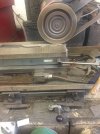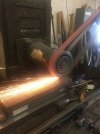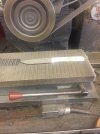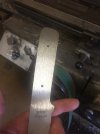Some real good advice you've been getting there. I run an 8x24" auto feed surface grinder, with 3 hp spindle. At first I ran a stone, then added coolant when it became apparent that any real hogging would require it. However, since most of what I use it for is billet work, I converted to run belts. It can be changed back pretty easily should I need that. However, I can hold .001" over a large workpiece and that's good for pretty much everything I do. A nice thing about belts is that those ceramics that get dog tired on your 2x72, freehanding, will cut for a long time still on the surface grinder. Regarding milling vs. grinding for billets, one big advantage is that the SG running belts does not much care about hard spots or whether the billet is normalized or annealed or whatever. That's the same reason I cut off with abrasive in most cases- takes a lot more time to be thermal cycling in between welding processes, just to be able to cut the material. Plus, it's way more cost effective to be extending the life of your ceramic belts using your SG, rather than worrying about expensive face mills running expensive carbid inserts, avoiding interrupted cuts while not taking too much off, and all the setup time and work holding issues that Javan mentions. Another point of his I'll repeat is how handy it is to just set it to work and walk away...
And if you ever get into sanmai kitchen knives, wowee an SG is the best. You want to turn big round 410 forged down into flatbar into thin, precision thickness sized stock for cladding, it's the best way I know.
I agree with most of this, but I will say that the whole "used belt" thing has never worked well for me. Maybe I'm too impatient, but in my experience dull belts from the 2x72 are pretty crap for grinding billets also, they load up fast, and seem to really induce a lot of stress and heat. They also tend to burnish the outside of the billets, which ends up requiring me to do an extra clean-up step, if I want to etch the billet for the customer to see the pattern. Without doing that, it doesn't etch worth a damn. Not saying I don't use old belts, but I find myself constantly regretting it.

I still haven't figured out the best belt value for grinding billets.
I will say that once I started pickling the scale off all my billets before surface grinding, belts are much more effective and lasting. Especially with the rolling mill, which seems to leave a super thick layer of seemingly compressed scale on the outside of billets for some reason.
I wanted to add Salem; I cut all my billets, without any annealing or thermal cycling (until after I'm done working them, obviously I anneal or TC for the customer), using a horizontal bandsaw and premium blades. I *hate* abrasive saws, they're horrible for your health, lungs, ears, everything, and they tend to really eat a lot of billet from kerf. Obviously if you're using L6 or making stainless damascus (which is the only reason I have one), you don't have much choice, but I've had zero issue cutting my billets super aggressively using the M71 premium high production blades from sawblade.com in fact, they'll cut faster than I'm comfortable with, and I've never worn one out cutting damascus. I usually screw it up cutting something really random, or dull it by cutting through rag micarta (which is hell on blades).
I buy the 3-4 TPI blades and keep them in my bigger horizontal, which has hydraulic downfeed, and run's 1" tall by 0.035" thick blades, running at 200 SFPM. I'm sure I could run at 300 which is that saw's max, but don't feel comfortable pushing it. Obviously using coolant (Trim Microsol 585xt, which I run in all my machines btw, was recommended by Nathan, and has been boss for me, no maintenance, and doesn't matter if it sits for months).
The only thing I've ever had trouble cutting with this saw and these blades, are non-annealed stainless billets (no go), and spring tempered 15n20 from Uddeholm, which is will cut, just slowly and kills the blades fast.




